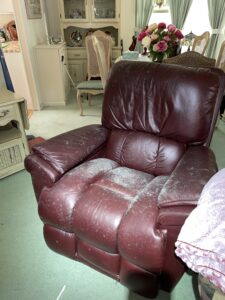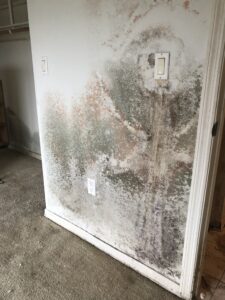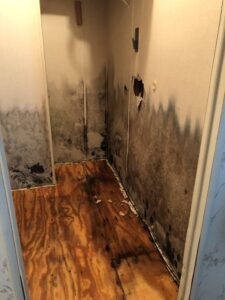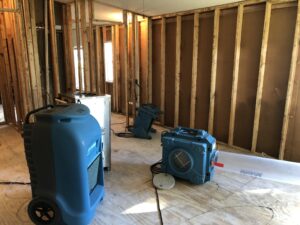Understanding mold growth is a very real cause of concern. Mold spores are microscopic, float in the air, and are present almost everywhere inside and outside. Mold spores get inside your home when you open doors, windows, and on your clothing or pets. Mold spores need moisture to grow. This can happen from excessive humidity related events. It also occurs from internal plumbing leaks or weather-related events that is not immediately handled by a professional. At times, until you see water coming out onto the floor, ceiling, or discoloration on the drywall, you don’t know that a plumbing pipe, toilet seal, or roof is leaking. By this time, the damage could be severe.
In some situations, it could be weeks or months before you detect an odor. The mold spores might not be visible but hidden behind drywall, cabinets, vanity’s, carpet, wood flooring, or other building materials. This hidden damage can reduce the indoor air quality in your home, cause health issues, and destroy the materials affected.
Most common symptoms of exposure to indoor mold
- Nasal & sinus congestion – sneezing
- Irritated eyes – itchy
- Throat irritation – coughing
- Headache
- Skin irritations or rash
Mold damage removal requires state licensing
Mold damage removal of more than 10sqft must be performed by someone who holds a State License from the Florida Department of Business & Professional Regulation. Since 2011 the State of Florida has regulated Mold Related services. The requirements of the license are that the remediator has taken approved certification classes, training regarding proper mold removal procedures, and they must obtain a $1,000,000.00 Commercial Pollution & General Liability policy. They must also take 24hrs of continuing education every two years, to renew their license.
The person onsite handling your mold remediation should show you their State License & Insurances. If the person holding the State License has technicians performing the remediation services, the person with the license is to be directly supervising the jobsite.
Mold Damage Removal & Remediation Procedures
- Contact a State Licensed Mold Assessor to perform a Mold Assessment, Air Samples – Swab Samples, and write a Mold Remediation Protocol. This will include a visual inspection of the area(s) of concern. Air samples determine if the indoor mold spore count is elevated or has cross contaminated an adjacent area. The outside air sample is used as a control for the Accredited Lab to determine the possible degree of elevation. The swab samples determine which specific molds are present on the materials. With this information it lets the remediator know how detailed the cleaning needs to be and how long the air scrubbers (HEPA air filtration devices) need to run, to achieve Clearance. This is also a contributing factor in costs. We have several third-party State Licensed Assessors we can refer to you.
- Look up mold remediation contractors in your area. Look at their Google Profile reviews including other site reviews (Angi, Porch, Yelp, Facebook). Look on their website for pictures, videos, and other detailed information. Call the company and ask for the name of the person who will be onsite performing the mold remediation services or supervising the technicians. Look online at the Department of Business and Professional Regulation’s website and search for their license. Make sure it is current and active, with no complaints. You will also see the date when they received their license.
Forward the Mold Remediation Protocol & Lab Results to the company point of contact. The remediator will need to review those documents and inspect your property to write an estimate. - Once the Mold Remediation has been completed per the Mold Remediation Protocol and industry standards (IICRC S500 & S520), the Mold Assessor can return to perform Post Remediation Verification (PRV) – Clearance testing. This will include confirming all building materials are within a dry standard, visually there is no debris, dust, dirt or mold in the affected area or on materials. The Assessor will take air samples and possibly swab samples to verify the indoor mold spore count is within normal limitations.
- When the air samples come back from the Accredited Lab and the State Licensed Mold Assessor has given a Clearance document, rebuild can begin. If the jobsite fails one or all the requirements to pass Clearance, the Mold Remediator MUST RETURN FREE OF CHARGE TO CORRECT THE ISSUE(S). THEY MUST ALSO PAY FOR THE MOLD ASSESSOR TO RETURN TO PERFORM ANOTHER CLEARANCE TEST.
Unlimited Restoration Specialist – experience & expertise you can trust
The State Licensed Mold Remediator is always on the jobsite, working alongside the trained technicians. We have over 30 years of experience performing thousands of water & mold damage cleanup services. We have knowledge from training, certifications, and State Licenses, including a State Licensed Insurance Adjuster. In the event you make a claim with your insurance company and it is covered, we can answer questions you may have. We can also work with your company and adjuster to bill them directly. In the event your claim is not covered or you choose not to make a claim, our pricing is competitive. You will receive more for your money by using our services.



